New Zealand is an island country in the southwest Pacific Ocean. It lies about 1,000 miles (1,600 kilometers) southeast of Australia. New Zealand consists of two main islands, called the North Island and the South Island, plus a number of smaller islands. New Zealand is also known by the traditional Māori name Aotearoa. The North Island is also called Te Ika-a-Māui. The Māori name for the South Island is Te Waipounamu. The country belongs to a large island group called Polynesia. Wellington is the capital of New Zealand, and Auckland is the largest city.

New Zealand was first settled by Polynesians from the eastern Pacific whose descendants are called Māori << MOW ree or MAH ree >>. Many scholars think these Polynesians arrived by about the A.D. 1200’s. British immigrants began settling in New Zealand during the early 1800’s, and the country became part of the British Empire in 1840. Today, it is an independent member of the Commonwealth of Nations, an association of countries that replaced the empire.
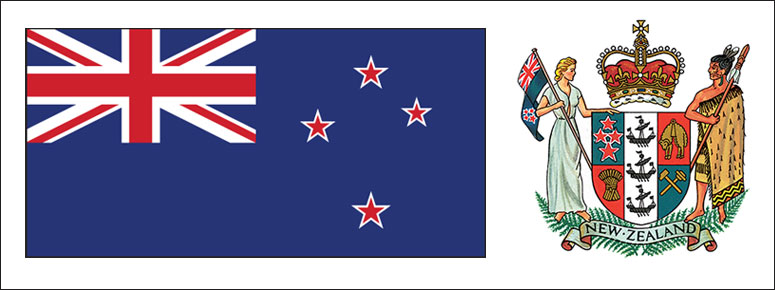
New Zealand’s current population represents many cultures. They include Māori and other Polynesian groups; descendants of English, Irish, and other western European colonial settlers; and more recent immigrants from Asia, Africa, and eastern Europe.
New Zealand is a beautiful country of snow-capped mountains, green lowlands, beaches, and many lakes and waterfalls. No place is more than 80 miles (130 kilometers) from the coast, and most places have striking views of mountains or hills.
For information about New Zealand’s government, history, and literature, see New Zealand, Government of; New Zealand, History of; New Zealand literature.
Loading the player...New Zealand national anthem
People
New Zealand has two main ethnic groups, Māori and whites of European ancestry. Māori make up about 15 percent of the population and form the country’s largest minority group. About 70 percent of the people are New Zealanders of European ancestry. The number of New Zealanders of other Pacific Island or Asian ancestry is growing. People of non-Māori ancestry are known as Pākehā (pronounced PAH keh hah). Many Pākehā are descended from British colonists who came to the country during the 1800’s, and so many New Zealand customs resemble British customs. However, New Zealand has developed its own sense of national identity as a country of both British and Polynesian heritage.
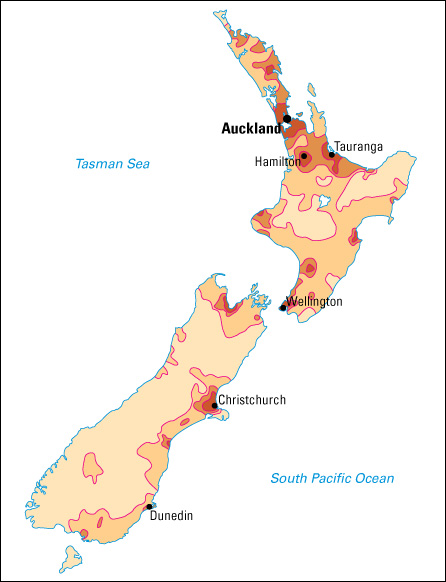
New Zealand has three official languages: English, Māori, and New Zealand Sign Language. English is the most widely used. Other languages spoken include Cook Island Māori, Dutch, Greek, Italian, Niuean, Samoan, and Tongan.

Way of life
City life.
New Zealand’s cities offer a wide range of economic and social opportunities. City dwellers can work in New Zealand’s business, communication, manufacturing, and shipping industries. Urban New Zealanders enjoy easy access to the fine arts, education, entertainment, and night life. New Zealand’s cities are fairly uncrowded. Some city dwellers live in high-rise apartment buildings, but most own their own homes.
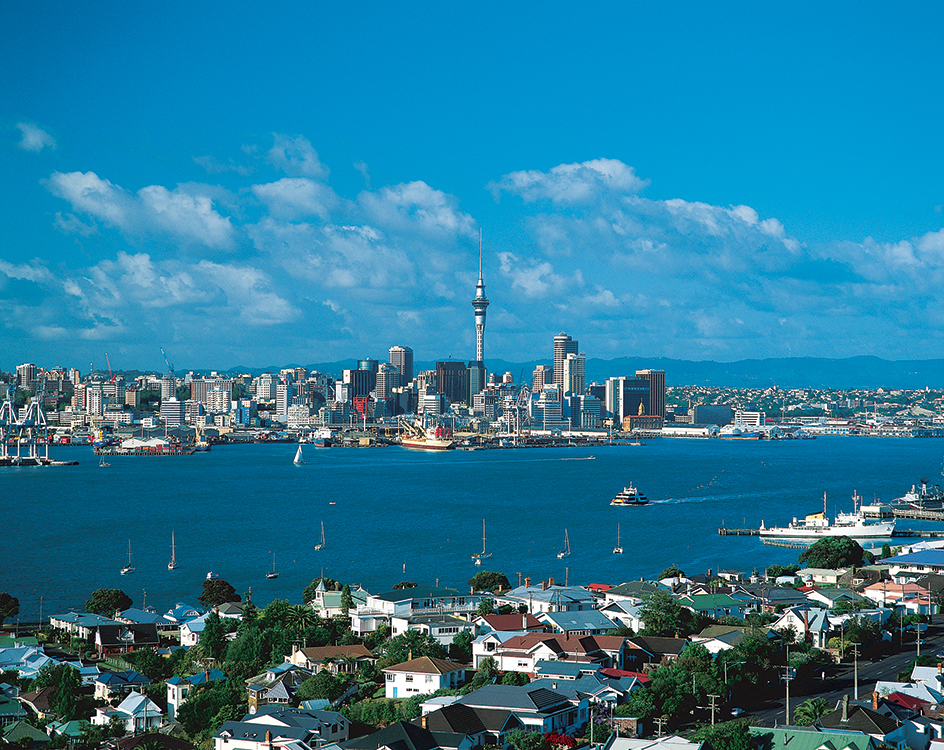
Rural life
in New Zealand centers mainly around agricultural activities such as raising sheep and cattle and growing fruits, vegetables, and grain. Many people in the northern part of New Zealand’s North Island raise dairy cattle. In other parts of North Island and on South Island, beef cattle and sheep are more common. Farmers produce large amounts of apples, kiwi fruit, and other fruits. Vineyards mainly in the southern regions of North Island, the northern regions of South Island, and the eastern regions of both islands grow grapes and produce New Zealand wine.
Food and drink.
New Zealand’s cooking combines British traditions with foods grown in the country. Traditionally, New Zealanders have favored beef, mutton, and venison served as steaks or sausages, or in meat pies. But vegetarianism is increasing in popularity. New Zealand’s coastal waters offer an abundance of seafood. Dairy products such as milk, cheese, and ice cream are important foods. A favorite dish is a sweet meringue dessert called pavlova. Tea, coffee, beer, and wine are popular beverages.
Recreation.
Sports and outdoor activities are important forms of recreation in New Zealand. New Zealanders enjoy Rugby Union, a form of rugby football generally regarded as the national sport. New Zealand’s national Rugby Union football team is called the All Blacks. Cricket is another popular spectator sport. In the summer, New Zealand’s mountainous terrain offers mountaineering, hiking, and climbing. In the winter, skiing and other snow sports are popular. New Zealand’s coastal waters attract many boaters and surfers. Horse racing has always been a favored leisure activity. 


Fishing and hunting are popular pastimes. Rainbow trout and brown trout abound in New Zealand’s lakes and rivers. The North Island’s warm coastal waters provide excellent line fishing and spear fishing. Boating offers the additional attraction of deep-sea fishing for marlin, shark, or tuna. The chief game birds for hunters are duck, swan, pheasant, quail, and geese.
Religion.
Many New Zealanders are Christians. The country has large numbers of Anglicans, Presbyterians, and Roman Catholics. The country also has many Hindus, Muslims, Sikhs, and people who belong to other religions. New Zealand has become more secular (nonreligious). About half of the country’s people have no religious affiliation.
Education.
New Zealand has public schools funded by the state and private schools, most of which are church sponsored. All children from the ages of 6 to 16 must attend school, though most children begin at the age of 5. Students who live in isolated areas or who have special physical or psychological needs may receive instruction from the Correspondence School in Wellington. The school also serves adults and pupils who wish to study courses not offered at their local schools. Almost all of New Zealand’s adults can read and write.
The country has eight universities. They are Massey University in Palmerston North; Victoria University of Wellington; Lincoln University, near Christchurch; the University of Auckland; Auckland University of Technology; the University of Canterbury in Christchurch; the University of Otago in Dunedin; and the University of Waikato in Hamilton. A number of technical and professional institutions also offer degrees. Institutions known as wānanga provide technical and university-level programs for Māori students, with an emphasis on Māori culture and language.
The arts.
New Zealand literature first gained widespread attention in the early and middle 1900’s. Katherine Mansfield wrote sensitive short stories about her childhood in New Zealand. Sylvia Ashton-Warner is known for her fiction and autobiographical books that draw upon her experiences as a teacher in rural New Zealand. Keri Hulme won fame for her fiction and poetry dealing with Māori language and culture. Other important New Zealand writers include James K. Baxter, Janet Frame, Ngaio Marsh, and Frank Sargeson.
Important New Zealand painters include Colin McCahon, Rita Angus, and Toss Woollaston. All three were leaders in introducing Modern styles to New Zealand art in the 1900’s. McCahon painted intense landscapes and religious scenes. Angus created vivid portraits and landscapes in both oil and water color. Woollaston painted landscapes as well as portraits of family and friends. Māori have maintained a long tradition of folk art, especially carefully detailed woodcarvings and intricate, swirling tattoos. Modern Māori artists have incorporated traditional Māori styles into painting and sculpture. 
In music, opera singer Kiri Te Kanawa won international acclaim as one of the finest sopranos of the later 1900’s. The New Zealand Symphony Orchestra is internationally recognized. The Royal New Zealand Ballet, established in 1953, is the oldest professional dance company in the country. The New Zealand School of Dance and Te Kura Toi Whakaari o Aotearoa: New Zealand Drama School offer courses in the performing arts. There are many local theater and music groups. 
New Zealand has many public museums and art galleries. New Zealand’s national museum—the Museum of New Zealand: Te Papa Tongarewa—opened in Wellington in 1998. The New Zealand Film Archive collects and preserves a national collection of New Zealand’s motion-picture history. The New Zealand Historic Places Trust preserves archaeological sites, historic areas and buildings, and sites of special significance to Māori.
The land
New Zealand lies in the southwest Pacific Ocean. The North Island and the South Island are New Zealand’s largest islands. They extend in a curve more than 1,000 miles (1,600 kilometers) long and cover about 99 percent of the country’s total area. Cook Strait, which is about 16 miles (26 kilometers) wide at its narrowest point, separates the islands.
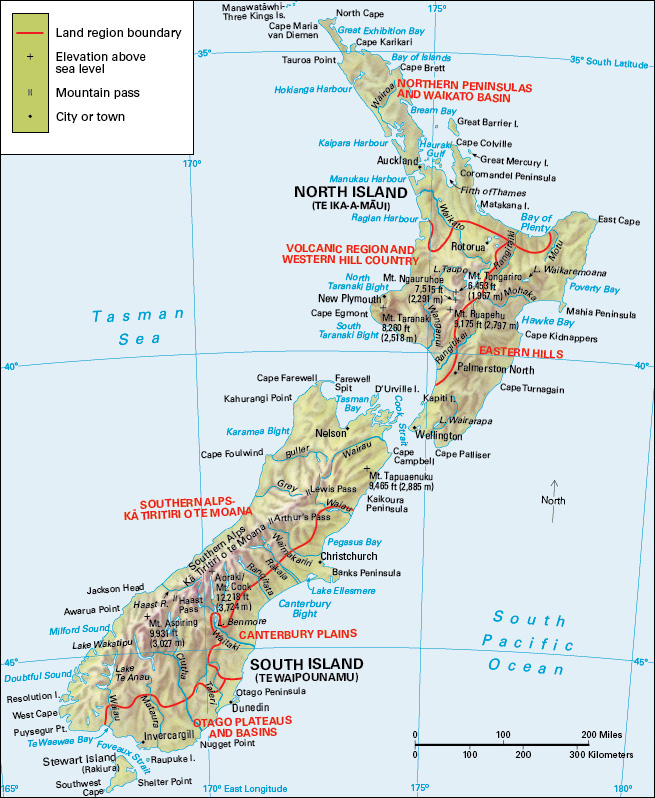
The North Island
can be divided into three main land regions: (1) the Northern Peninsulas and Waikato Basin, (2) the Volcanic Region and Western Hill Country, and (3) the Eastern Hills.
The Northern Peninsulas and Waikato Basin
occupy most of the northern part of the island. This region has forests, rich lowlands, and undeveloped hill country. In the lower lands, many farmers grow citrus or kiwi fruits or raise dairy cattle. Beef cattle and sheep are raised in the hill country. Long, sandy beaches line the west coast, and many inlets mark the east coast.
The Volcanic Region and Western Hill Country
cover the western half of the island south of the Northern Peninsulas and Waikato Basin. Much of the region consists of volcanic rock. A large plateau covered with soft, yellow-brown soil made up of crushed pumice—the porous stone thrown off by volcanoes—rises along the eastern part of the region in the center of the North Island.
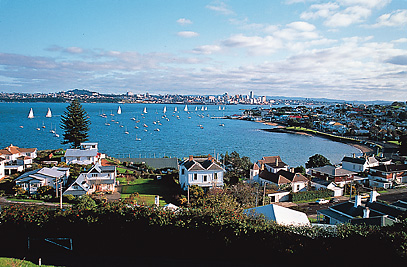
This region has several active volcanoes, including Mount Tongariro, and the highest peak on the island, 9,175-foot (2,797-meter) Mount Ruapehu. This region also has many hot springs and geysers.
The Eastern Hills
occupy the eastern and southern parts of North Island. A mountain system runs through the region from East Cape to Cook Strait. The eastern slopes consist mainly of rugged hills. Ranchers use this land for grazing sheep and beef cattle. Lowlands along the east coast are used for growing vegetables and fruits. To the west of the mountains are lowlands and plains. Farmers raise dairy cattle, other livestock, and crops in this region. 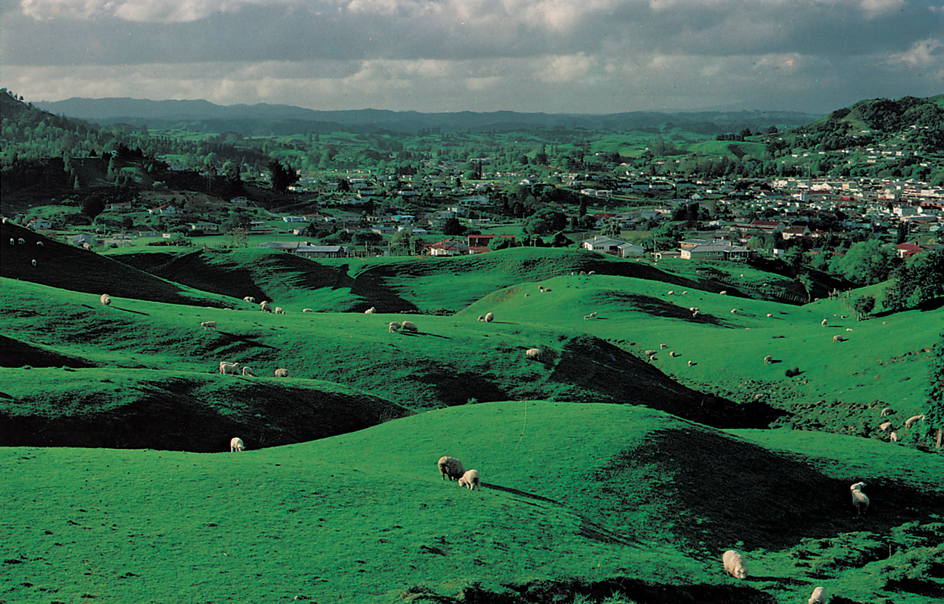
The South Island
has three main regions: (1) the Southern Alps/Kā Tiritiri o te Moana and High Country, (2) the Canterbury Plains, and (3) the Otago Plateaus and Basins.
The Southern Alps/Kā Tiritiri o te Moana and High Country
cover most of the island. The highest peak in New Zealand is the 12,218-foot (3,724-meter) Aoraki/Mount Cook. It rises in the Southern Alps, which are also known by their Māori name, Kā Tiritiri o te Moana. Aoraki, also spelled Aorangi, is the Māori name for the mountain. It is usually translated as cloud piercer. The Aoraki/Mount Cook region has some of New Zealand’s most spectacular scenery. Glaciers lie on mountain slopes high above thick, green forests. Sparkling lakes nestle in valleys throughout the regions. 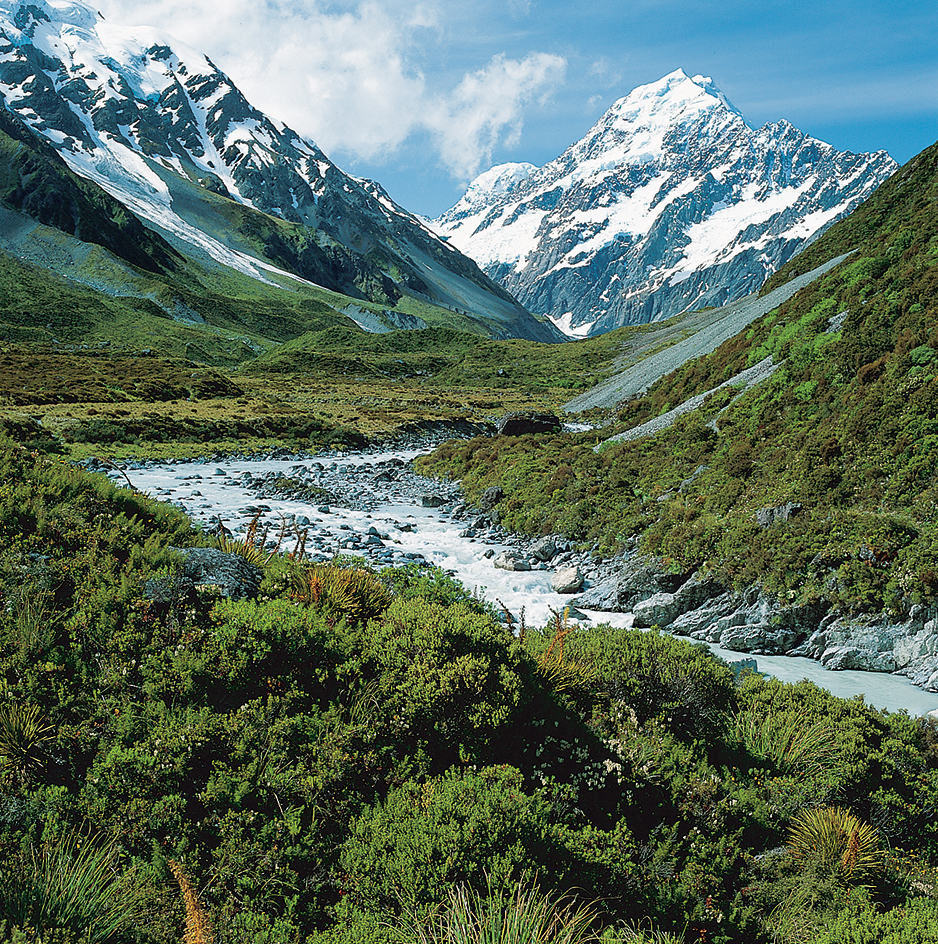
The western slopes of the Southern Alps/Kā Tiritiri o te Moana and High Country region are forested, rainy, and rugged. The eastern slopes are lower and much less rainy. Along the southwest coast, long inlets of the sea called fiords cut into the land, creating a jagged coastline. Forested mountains border many of the fiords.
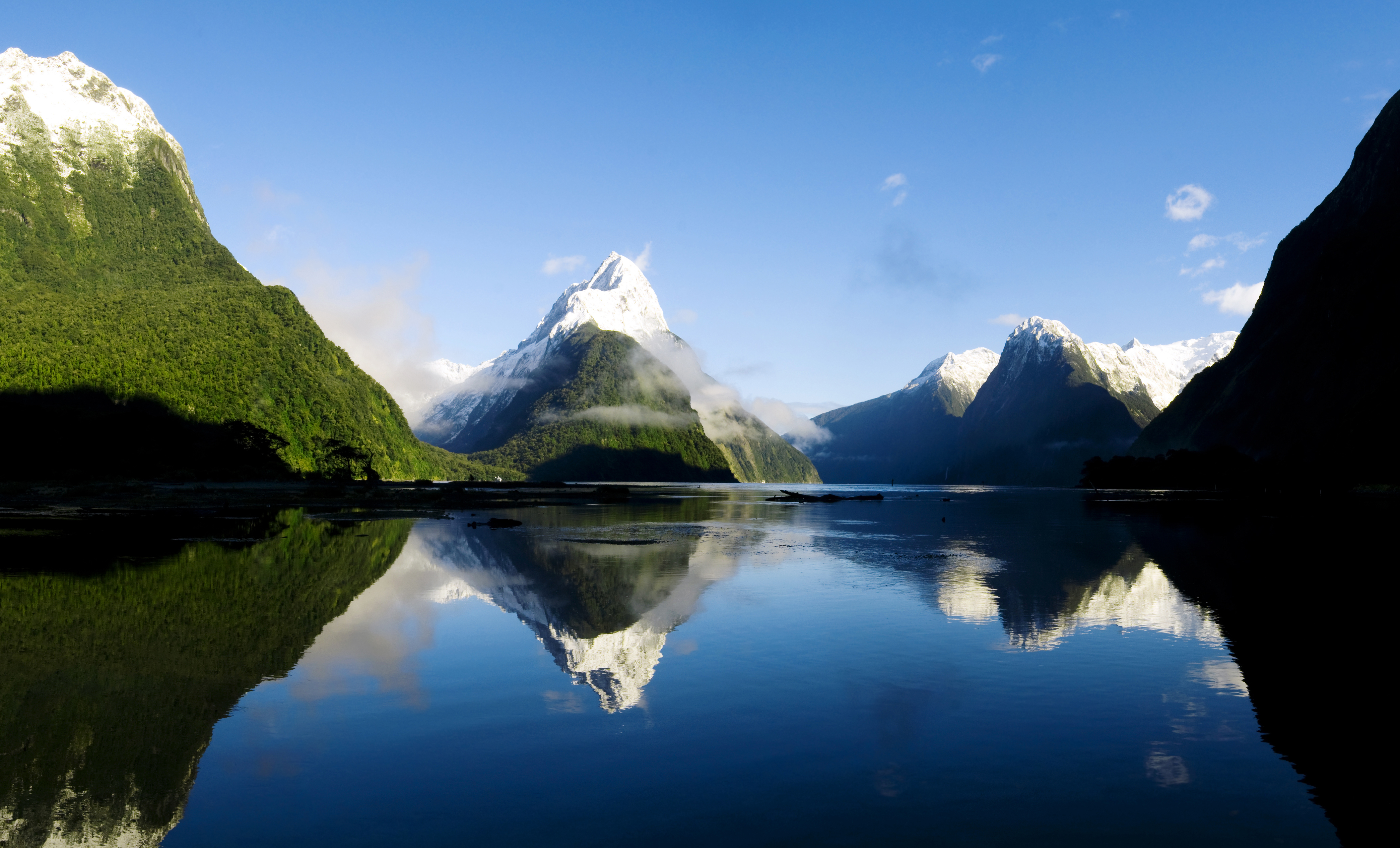
The Canterbury Plains
lie along the east-central coast of the South Island. They form New Zealand’s largest area of flat or nearly flat land and make up the chief grain-growing region. The plains are laid out in a patchwork of fields on which farmers grow barley, fodder crops, oats, and wheat. The plains are also an important region for raising sheep.
The Otago Plateaus and Basins
lie in the southeast corner of the South Island. The region has plains and rolling hills, where crops and livestock are raised.
Other islands.
Stewart Island lies about 20 miles (32 kilometers) south of the South Island. Scrubby bushes cover most of the island. Most of the people earn their living by fishing and oyster gathering.
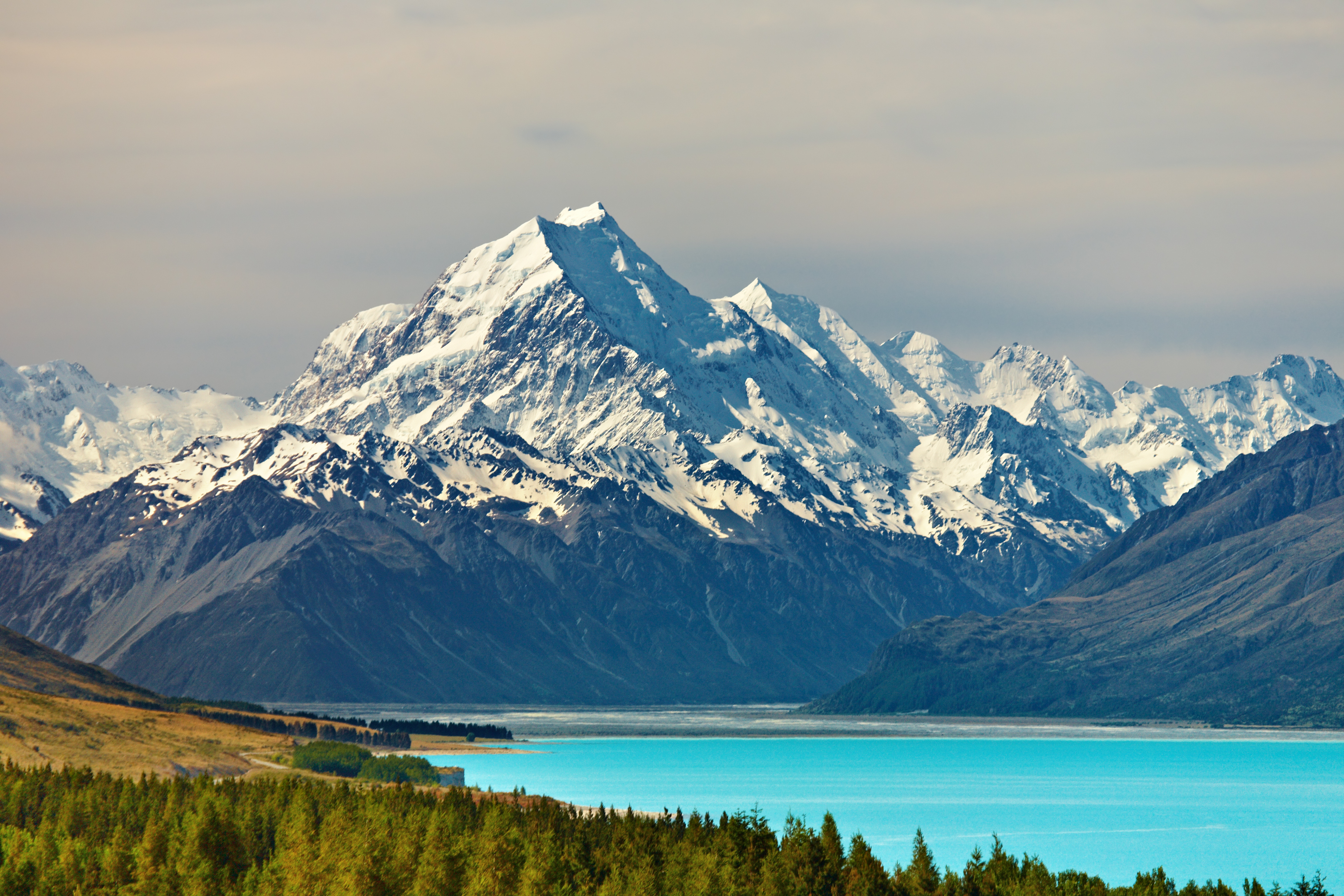
The Chatham Islands lie about 530 miles (850 kilometers) east of the South Island. Most Chatham Islanders are Māori. Fishing and sheep farming are their main occupations.
The country’s other islands and island groups are the Antipodes Islands, the Auckland Islands, the Bounty Islands, Campbell Island, the Kermadec Islands, the Snares Islands, Solander Island, and Manawatāwhi/Three Kings Islands. Of these, only Campbell Island has a permanent population.
Lakes, rivers, and waterfalls.
New Zealand has many rivers, lakes, and waterfalls. In the alpine regions of the South Island, mountain snows and glaciers feed many rivers. The North Island has New Zealand’s longest river, the Waikato, which flows 264 miles (425 kilometers). The island also has the largest lake, Lake Taupo, which covers 234 square miles (606 square kilometers) and is a vacation area famous for trout fishing. 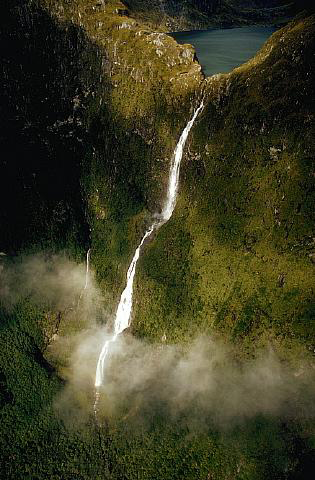
On both islands, the rivers rise in the mountains and flow down to the sea. Most of the rivers flow swiftly and are difficult to navigate. The Clutha River on the South Island carries the largest volume of water. The rapid flow of the rivers makes them important sources of hydroelectric power.
New Zealand has many waterfalls. Sutherland Falls tumbles 1,904 feet (580 meters) down a mountain near Milford Sound on the South Island.
Animal life.
The islands of New Zealand were isolated for about 80 million years. As a result, the animal life is unique but limited in variety. There are many species of beetles, flies, and moths. The islands have several types of frogs, geckos, and skinks, and an ancient reptile called the tuatara. The only native land mammals are bats, but dolphins, seals, and whales live in the surrounding ocean. There are also many species of coastal and wetland birds. The flightless kiwi lives only in New Zealand. Kiwi has become a nickname for a New Zealander. The kea is a parrot noted for its playfulness. 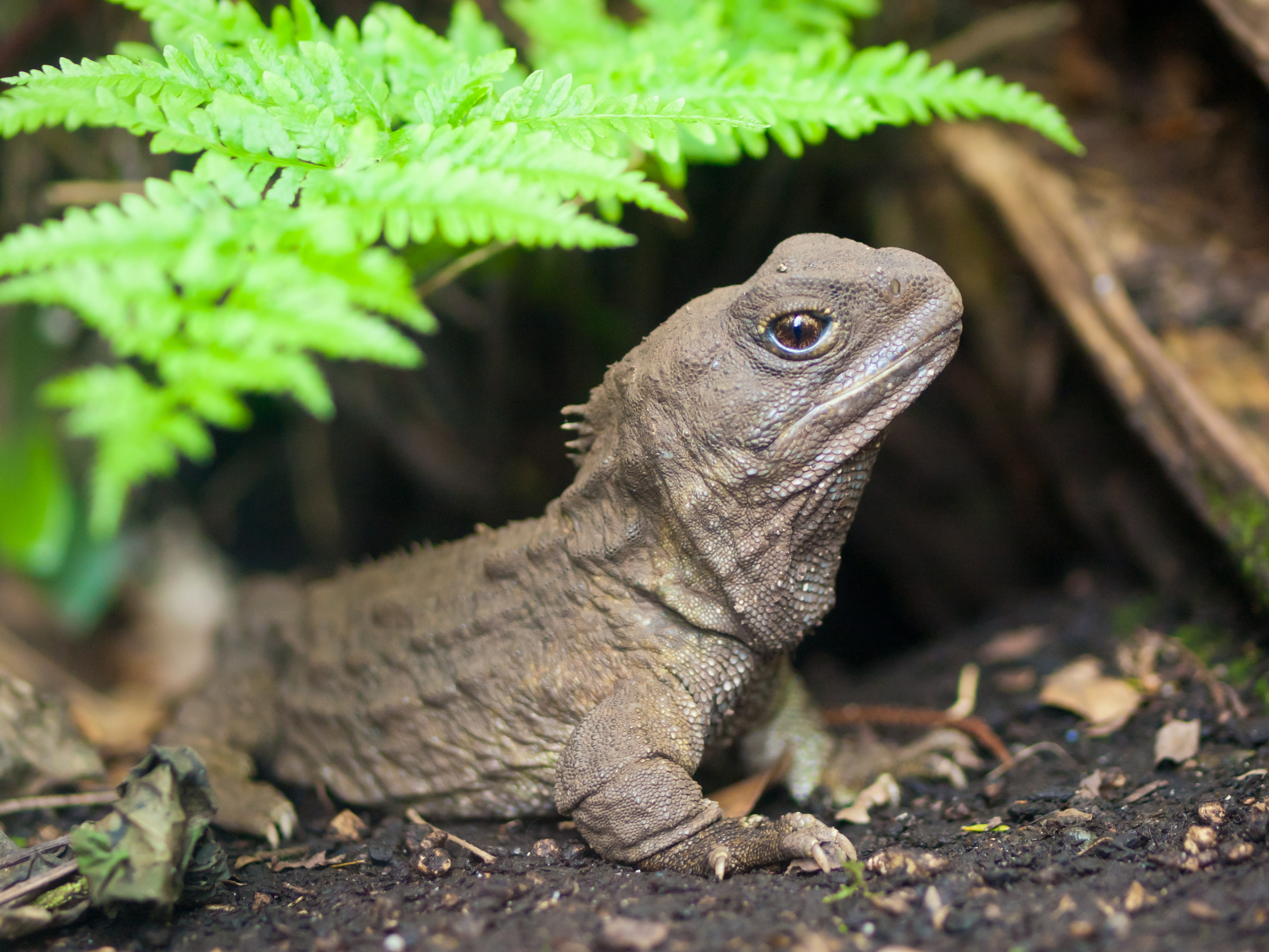

Settlers introduced many animal species from other lands. Māori ancestors introduced the dog and one type of rat to the islands. Europeans brought many other animals, including deer and rabbits, as well as cattle, pigs, and sheep. Wallabies and brush-tailed possums came from Australia. The new species have depleted the native species to the extent that many are now severely endangered.
Plant life.
About 7,000 years ago, rain forests covered most of what is now New Zealand. In the relatively dry region of the Otago Plains in the south of South Island, grasses and shrubs flourished. As the climate cooled, plant species sensitive to frost diminished, while the more cold-tolerant species thrived, especially in the upland areas. Low forests developed on the South Island. On the North Island, broadleaf and cone-bearing trees, such as the kauri, became more widespread. Beech forests grow on the cooler uplands of both islands. Since 1900, people have introduced many foreign trees into New Zealand.
Earthquakes.
New Zealand has about 100 earthquakes every year that are strong enough to be felt. The country’s most disastrous earthquake occurred near Hawke’s Bay in 1931. It killed 256 people and badly damaged the cities of Hastings and Napier. In early 2011, a 6.3-magnitude quake devastated Christchurch, killing more than 180 people. In late 2016, a 7.8-magnitude quake struck the South Island, causing widespread damage.
Climate
The country has a mild, moist climate. New Zealand lies south of the equator, so its seasons are opposite those of the Northern Hemisphere. July is New Zealand’s coldest month, and January and February are the warmest months. The country’s mild climate results from ocean breezes that bring warmth in winter and cool temperatures in summer. Average summer temperatures range from about 59 °F (15 °C) to about 69 °F (20 °C), but summer temperatures occasionally rise above 90 °F (32 °C). Average winter temperatures range from about 35 °F (2 °C) to about 53 °F (12 °C). 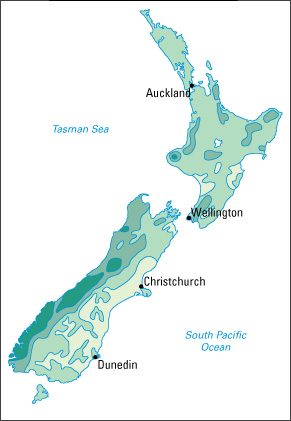
Climate regions.
On the North Island, the northern tip of the Northland Peninsula is warm and humid all year. The island’s central plateau has hot, sunny weather in summer and sharp frosts with occasional snow in winter. Wellington lies exposed to the frequent gales of Cook Strait. On the South Island, the rainy west contrasts with the drier east. Southern New Zealand is cooler than northern New Zealand.
Rainfall.
The mountains chiefly control the distribution of rainfall in New Zealand. Winds from the west carry moisture from the ocean. This moisture falls as rain on the western slopes of the mountain ranges. Almost the entire west coast of South Island averages more than 80 inches (200 centimeters) of rain a year. Milford Sound, on the South Island, averages about 260 inches (660 centimeters) of rain each year. East of the mountains, the winds lose most of their moisture. Some eastern regions in the country average less than 20 inches (51 centimeters) of rain a year. Snow seldom falls in lowland areas, though some mountain peaks remain snow-capped all year.
Economy
For many years, New Zealand’s economy depended largely on agriculture. Agriculture remains important, but changing domestic and international conditions have caused a shift in economic activity. Today, the most important economic sector is service industries. Service industries account for over two-thirds of both New Zealand’s employment and its gross domestic product—the total value of all goods and services produced within the country in a year. Tourism is important to New Zealand’s economy. Millions of people visit from Australia, the United Kingdom, the United States, and other countries.
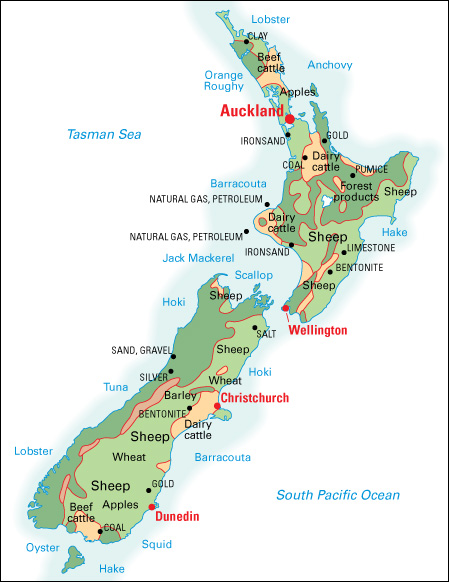
Manufacturing.
Much of New Zealand’s manufacturing is dedicated to making dairy products, meat, paper, wood, and other agricultural and forest products. Factories also manufacture chemicals, machinery, and transportation equipment. These industries tend to be based in the larger commercial centers, especially Auckland. Since the mid-1900’s, manufactured products have become an important export.
Agriculture.
New Zealand’s agriculture centers on raising cattle and sheep for dairy products, meat, and wool. These products are among the country’s leading exports. New Zealand is one of the world’s leading producers of both milk and wool. Cattle are raised throughout the North Island, and many sheep are raised in the Eastern Hills. On the South Island, cattle and sheep are both primarily raised in the Canterbury Plains and at the southern end of the island. Chickens provide eggs and meat. The major crops include apples, barley, grapes, kiwi fruit, onions, potatoes, tomatoes, and wheat. 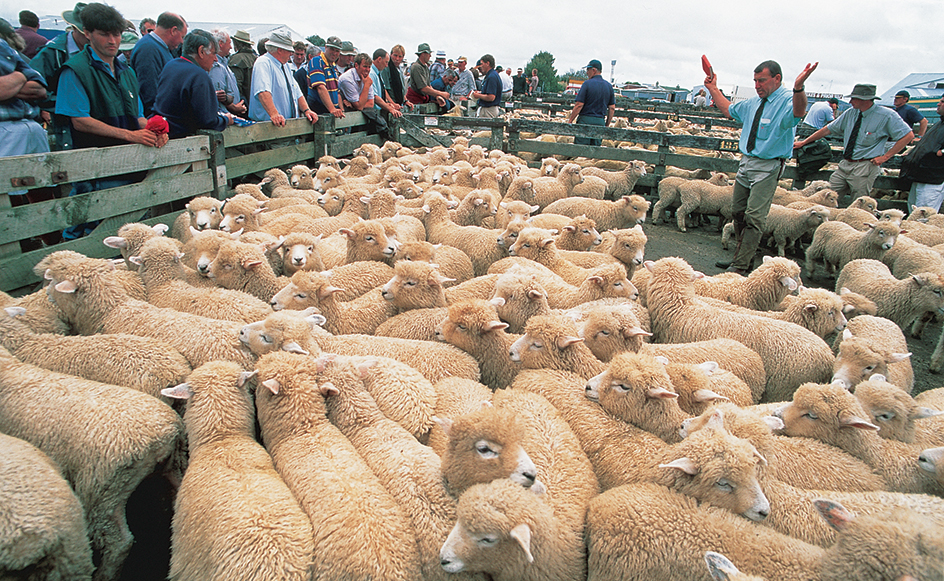
Mining.
New Zealand contains a wide variety of minerals. The country is probably best known for its gold, but the mining industry also produces clay, coal, dimension stone (stone cut to specific sizes and shapes), ironsand (sand containing iron ore), lime, limestone, marble, natural gas, oil, salt, silver, and other mineral products.
Forestry.
Much of New Zealand’s indigenous (native) forests grow in the mountain regions on the west coast of the South Island. A small percentage of the country’s total forest production is harvested from indigenous forests. The vast majority of the timber comes from planted forests, mostly the fast-growing Monterey pine. The logs are manufactured into plywood, veneer, wood pulp, and other wood products.
Fishing industry.
New Zealand’s exclusive economic fishing zone is one of the largest in the world, an area about 15 times larger than the country’s land mass. Valuable commercial fish include blue grenadier (also called hoki), jack mackerels, orange roughy, snoek (also called barracouta), southern blue whiting, squid, and tuna. Mussels, oysters, and salmon are important aquaculture products.
Energy.
Water power provides about half of New Zealand’s electric power. Underground steam in the North Island’s volcanic area has become an increasingly important source of power. Most of the remaining power comes from coal, natural gas, and oil. Wind power supplies a small, but growing, amount of energy.
International trade.
New Zealand’s leading trade partners are Australia, China, Japan, and the United States. The country also conducts trade with Germany, Malaysia, Singapore, South Korea, and the United Kingdom. New Zealand’s leading exports include aluminum, dairy products, fish, fruits, machinery, meat, wood and wood products, and wool. The country imports aircraft, machinery, petroleum and petroleum products, and plastics.
Transportation.
New Zealand has tens of thousands of miles of roads and millions of motor vehicles. The country also has an extensive rail system to carry both passengers and freight.
Air transportation is important to New Zealand. Air New Zealand is the major domestic airline. The country’s largest international airports are in Auckland, Christchurch, and Wellington. While international air links have helped overcome the country’s geographical isolation, New Zealand still relies heavily on sea transport for overseas trade. Auckland is the nation’s chief seaport. 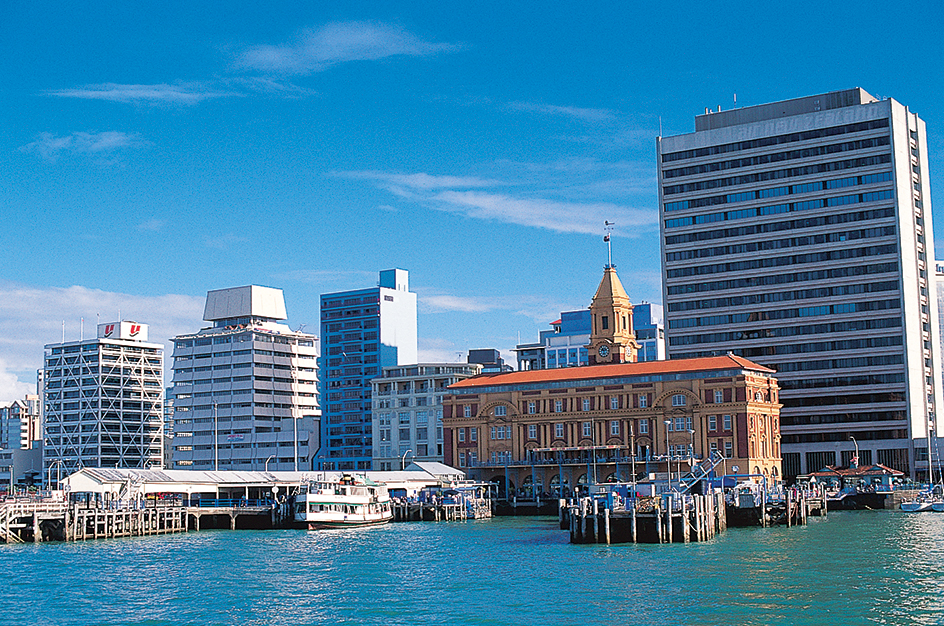
Communication
is one of the most rapidly growing sectors of the New Zealand economy. Television New Zealand operates six television channels, and Radio New Zealand Limited operates three radio networks. The country also has privately owned radio and television stations. Māori language radio and television stations promote Māori culture.
New Zealand has many daily newspapers, most of which are published in the evening. The New Zealand Herald, based in Auckland, has the largest circulation.
